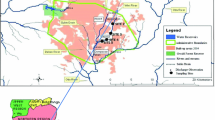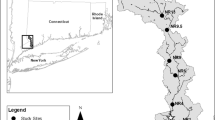Abstract
The Holtemme is a small headwater stream in North Germany’s Elbe River Basin. According to German and European legislation, hygienic monitoring is not mandatory for such water bodies which are neither drinking water sources nor categorized as bathing waters. Consequently, relatively little is known about the occurrence of–potentially pathogenic–bacteria and viruses in Germany’s streams and rivers. The Holtemme was selected for a case study because it is relatively well monitored for both chemical water quality and aquatic ecology, but not for hygiene. Originating in the mountains of Harz Nature Park, the 47 km long Holtemme is characterized by a strong longitudinal gradient in chemical water quality, which is related to different land uses and the influx of treated wastewater from two urban areas (Wernigerode and Halberstadt). Waste water loads received by the Holtemme are comparatively high when compared to similarly small streams.
In 2015, total coliform concentrations between more than 200 and 77,010 bacteria per 100 mL, and fecal coliform concentrations between 5 and 24,060 bacteria per 100 mL were observed in the Holtemme’s main channel. The highest concentrations were typically found below the outlets of the two wastewater treatment plants. The treated wastewater contained total and fecal coliform concentrations of up to 200,500 and 83,100 per 100 mL, respectively; however, there were significant temporal variations. While the observed concentrations are unproblematic from a legal perspective (because no maximum permissible limits are defined for streams in Germany), they would exceed the tolerable limits for bathing waters in the EU, indicating moderate to critical pollution limits.
Similar content being viewed by others
References
Abraham W R, Petzoldt H, Strauch G (2005). Infektionsrisiken durch Mikroorganismen im Flutwasser. In: Böhme M, Krüger F, Ockenfeld K, Geller W, eds. Schadstoffbelastung nach dem Elbe-Hochwasser 2002, 60–66. Magdeburg, Germany: UFZ-Umweltforschungszen-trum Leipzig-Halle GmbH
Bagde U S, Rangari A K (1999). Periodicity of coliform bacteria in an aquatic environment. Water Sci Technol, 40(7): 151–157
Bessa L J, Barbosa-Vasconcelos A, Mendes Â, Vaz-Pires P, Martins da Costa P (2014). High prevalence of multidrug-resistant Escherichia coli and Enterococcus spp. in river water, upstream and downstream of a wastewater treatment plant. J Water Health, 12(3): 426–435
Bougeard M, Le Saux J C, Teillon A, Belloir J, Le Mennec C, Thome S, Durand G, Pommepuy M (2011). Combining modeling and monitoring to study fecal contamination in a small rural catchment. J Water Health, 9(3): 467–482
Ecosystem Saxonia (2014). Anwendung der BWK-Merkblätter M3 /M7 für den einfachen und detaillierten Nachweis für die immissionsbezogene Beurteilung von Niederschlagswassereinleitungen aus dem Mischwassernetz der Ortslage Halberstadt in die Holtemme mit dem Programm Verena.M7. Unpublished Document
Edeline F, Lambert G (1979). Self-purification of rivers a two-phase model for bacterial biodegradation. Water Res, 13(6): 473–480
Funari E, Manganelli M, Sinisi L (2012). Impact of climate change on waterborne diseases. Annali dell’ Instituto superiore di sanità, 48(4): 473–487
Graw M, Borchardt D (1995). Hygienerelevante Belastungen von Fließgewässern: Bewertung und Sanierungsmöglichkeiten am Beispiel der Lahn. gwf Wasser Abwasser, 136(11): 567–571
Kamjunke N, Büttner O, Jäger C G, Marcus H, von Tümpling W, Halbedel S, Norf H, Brauns M, Baborowski M, Wild R, Borchardt D, Weitere M (2013). Biogeochemical patterns in a river network along a land use gradient. Environ Monit Assess, 185(11): 9221–9236
Kammerad B (2011). Die Holtemme. Angler und Fischer in Sachsen- Anhalt, 14): 19–20
Karrasch B, Mehrens M, Link U, Herzog M (2004). Teilprojekt 9: Schadstoffbelastung und Selbstreinigungsvermögen der Elbe. In: Geller W, Ockenfeld K, Böhme M, Knöchel A, eds. Schadstoffbelastung nach dem Elbe-Hochwasser 2002, 389–402. Magdeburg, Germany: UFZ- Umweltforschungszentrum Leipzig-Halle GmbH
Karthe D (2015). Bedeutung hydrometeorologischer Extremereignisse im Kontext des Klimawandels für die Trinkwasserhygiene in Deutschland und Mitteleuropa. Hydrol Wasserbewirtsch, 59(5): 264–270
Karthe D, Behrmann O, Blättel V, Elsässer D, Heese C, Ho J, Hügle M, Hufert F, Kunze A, Niessner R, Ho J, Scharaw B, Spoo M, Tiehm A, Urban G, Vosseler S, Westerhoff T, Dame G, Seidel M (2016). Modular development of an inline monitoring system for waterborne pathogens in raw and drinking water. Environ Earth Sci, 75(23): 1481
Kirschner A K T, Kavka G G, Velimirov B, Mach R L, Sommer R, Farnleitner A H (2009). Microbiological water quality along the Danube River: integrating data from two whole-river surveys and a transnational monitoring network. Water Res, 43(15): 3673–3684
Kistemann T, Christoffels E, Franke C, Rechenburg A, Willkomm M, Exner M (2007). Mikrobielle Belastung der Fließgewäßser aus diffusen Eintragspfaden am Beispiel der Swist. Abschlußbericht zum Forschungsprojekt „Swist III“. Institut für Hygiene und Öffentliche Gesundheit der Universität Bonn und Erftverband, Bergheim
Kistemann T, Classen T, Koch C, Dangendorf F, Fischeder R, Gebel J, Vacata V, Exner M(2002). Microbial load of drinking water reservoir tributaries during extreme rainfall and runoff. Appl Environ Microbiol, 68(5): 2188–2197
Länderarbeitsgemeinschaft Wasser (= LAWA) (2003). Arbeitshilfe zur Umsetzung der EG-Wasserrahmenrichtlinie
Landesbetrieb für Hochwasserschutz und Wasserbewirtschaftung (= LHW) Sachsen-Anhalt (2012). Deutsches Gewässerkundliches Jahrbuch. Elbegebiet, Teil I: Von der Grenze zur CR bis zur Havelmündung. Magdeburg, Germany
Landesbetrieb für Hochwasserschutz und Wasserbewirtschaftung (= LHW) Sachsen-Anhalt (2016). Discharge data for the Holtemme at Steinerne Renne and Mahndorf. http://www.hochwasservorhersage.sachsen-anhalt.de/wiskiwebpublic/list_W_2.htm
Lange K P, Franke D, Kußmann S (2014). Bewertung der Mischwaßsereinleitungen von Halberstadt in die Holtemme–Ableitung situationsgerechter Maßnahmen. Wasser und Abfall, 16(9): 10–17
St Laurent J, Mazumder A (2014). Influence of seasonal and inter-annual hydro-meteorological variability on surface water fecal coliform concentration under varying land-use composition. Water Res, 48: 170–178
Mälzer H J, aus der Beek T, Müller S, Gebhardt J (2015). Comparison of different model approaches for a hygiene early warning system at the lower Ruhr River, Germany. Int J Hyg Environ Health
Noble R T, Lee I M, Schiff K C (2004). Inactivation of indicator microorganisms from various sources of faecal contamination in seawater and freshwater. J Appl Microbiol, 96(3): 464–472
Pitkänen T, Paakkari P, Miettinen I T, Heinonen-Tanski H, Paulin L, Hänninen M L (2007). Comparison of media for enumeration of coliform bacteria and Escherichia coli in non-disinfected water. J Microbiol Methods, 68(3): 522–529
Reder K, Flörke M, Alcamo J (2015). Modeling historical fecal coliform loadings to large European rivers and resulting in-stream concentrations. Environ Model Softw, 63: 251–263
Rompré A, Servais P, Baudart J, de-Roubin M R, Laurent P (2002). Detection and enumeration of coliforms in drinking water: current methods and emerging approaches. J Microbiol Methods, 49(1): 31–54
Sächsisches Landesamt für Umwelt und Geologie (= SLUG) (2002). Bewertung der Gewässerbelastung im Elbeeinzugsgebiet. August–Hochwasser 2002, Berichtszeitraum 15. August bis 6. September 2002. Dresden, Germany
Schreiber C, Kistemann T (2012). Antibiotic resistance among autochthonous aquatic environmental bacteria. Water Sci Technol, 67(1): 117–123
Schreiber C, Rechenburg A, Koch C, Chriftoffels E, Claßen T, Willkomm M, Mertens F M, Brunsch A, Herbst S, Rind E, Kistemann T (2016). Two decades of system-based hygienicmicrobiological research in Swist river catchment (Germany). Environ Earth Sci, doi: 10.1007/s12665-016-6100-9
Schultz-Fademrecht C, Wichern M, Horn H (2008). The impact of sunlight on inactivation of indicator microorganisms both in river water and benthic biofilms. Water Res, 42(19): 4771–4779
Schulz C J, Childers G W (2011). Estimating changes in river faecal coliform loading using nonparametric multiplicative regression. J Water Health, 9(1): 117–127
Shelton D R, Pachepsky Y A, Kiefer L A, Blaustein R A, McCarty GW, Dao T H (2014). Response of coliform populations in streambed sediment and water column to changes in nutrient concentrations in water. Water Res, 59: 316–324
Sorokovikova L M, Popovskaya G I, Tomberg I V, Sinyukovich V N, Kravchenko O S, Marinaite I I, Bashenkhaeva N V, Khodzher T V (2013). The Selenga river water quality on the border with Mongolia at the beginning of the 21st Century. Russ Meteorol Hydrol, 38(2): 126–133
Stapleton C, Wyer M, Crowther J, McDonald A, Kay D, Greaves J, Wither A, Watkins J, Francis C, Humphrey N, Bradford M (2008). Quantitative catchment profiling to apportion faecal indicator organism budgets for the ribble system, the UK’s sentinel drainage basin for water framework directive research. J Environ Manage, 87 (4): 535–550
Strauch G, Sbjeschni A, Bittkau A, Schlosser D (2004). Teilprojekt 6: Schadstofftransport in überfluteten Trinkwassereinzugsgebieten. In: Geller W, Ockenfeld K, Böhme M, Knöchel A (Ed). Schadstoffbelastung nach dem Elbe-Hochwasser 2002, pp. 305–313. Magdeburg, Germany: UFZ- Umweltforschungszentrum Leipzig-Halle GmbH
Taiwan Environmental Protection Administration (EPA) (2016). Regulations for River Monitoring. Online at http://wq.epa.gov.tw/Code/ Business/Statutory.aspx?Languages= en; last accessed on 8 July 2016
Tiefenthaler L, Stein E, Lyon G (2009). Fecal indicator bacteria (FIB) levels during dry weather from Southern California reference streams. Environ Monit Assess, 155(1–4): 477–492
Acknowledgements
This study was funded by the Helmholtz Centre for Environmental Research. We thank Ms. Gunsmaa Batbayar for assisting us during three sampling campaigns, and Florian Pöhlein for assisting us during one sampling campaign. We thank the reviewers for their detailed comments which have helped to improve this manuscript significantly.
Author information
Authors and Affiliations
Corresponding author
Rights and permissions
About this article
Cite this article
Karthe, D., Lin, PY. & Westphal, K. Instream coliform gradients in the Holtemme, a small headwater stream in the Elbe River Basin, Northern Germany. Front. Earth Sci. 11, 544–553 (2017). https://doi.org/10.1007/s11707-017-0648-x
Received:
Accepted:
Published:
Issue Date:
DOI: https://doi.org/10.1007/s11707-017-0648-x




